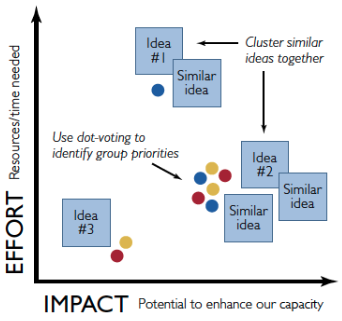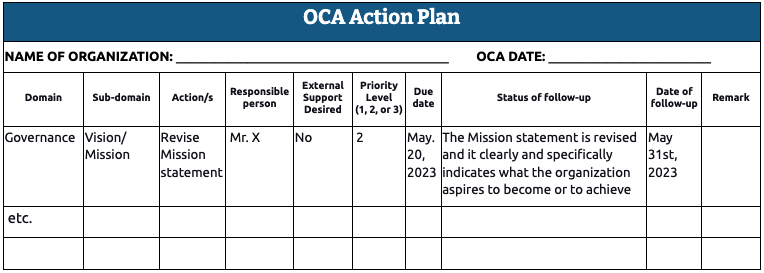By Yitbarek Woldetensay, Chelsie Kuhn, and Alison Harrell
Introduction
In Part 1 of this blog series, we described an Organizational Capacity Assessment (OCA), why we conduct an OCA, and how to prepare for the OCA process. In this Part 2 blog post, we will describe how to conduct organizational capacity gap identification (including OCA workshop facilitation, analysis of findings, and development recommendations), adaptive action planning, and implementation.
How Do You Facilitate and Guide an OCA?
Facilitating and guiding an OCA requires implementers to take a number of details into consideration to conduct a high-quality assessment. Best practices include having an external actor facilitate for the organization to ensure some degree of separation, scheduling to enable majority participation, and building consensus among attendees for clarity on scoring. These considerations will be described in more detail below.
Considerations: A small group might have conducted the OCA preparation phase, but for the actual assessment, measuring the organization’s capacity, the participation of a cross-section of the organization is essential. It should have inclusive involvement of representatives from all levels within the organization to enable a holistic view of capacities. Thus, planning for and avoiding any predictable obstacles for full participation is essential. For example, the OCA workshop should be scheduled on consecutive business days to keep the momentum going and avoid planning around important deadlines or holidays. The workshop should be conducted at the office where the participants work so that additional staff can help answer questions and/or the facilitator can quickly obtain other supporting documentation. Hosting at the organization’s office also reinforces the perception that this is their self-assessment within their operating environment. Organization members are primed and can draw upon experiences they’ve seen in the setting directly around them, which might reduce recall bias and promote improved response and ownership of the process.
Introductory Session: The OCA assessment workshop starts with an introductory session. During the introduction session, the facilitator should explain why the organizational capacity assessment is needed, mention that the assessment aims to measure current capacity rather than that of the past, and remind the participants that low scoring is not bad; it just illustrates areas that need support and should be focused on in the future. The facilitator should also describe what will happen after the assessment, such as developing and finalizing the report and subsequent adaptive action planning, implementation, follow-up, and iterative assessments if needed. Lastly, the facilitator should inform the participants that there is a need for participants to be as honest and realistic as possible. Participants should be free to express themselves and listen to different views attentively.
Self-assessment and scoring: After the introduction, the participants’ version of the assessment tool should be handed out to the participants, and the facilitator should support the scoring process. There are different ways of scoring the statements, including group consensus through score, group consensus through questions and discussion, and Octagon, a technique for visualizing an organization’s capacity. For example, the group consensus through scores process begins with the facilitator reading the statement. Then participants are requested to put a scoring card with their rating for the statement (e.g., 1, 2, 3, 4, or 5) and face down in the center of the table. Once everyone has put in a scorecard, the cards are turned face up. The facilitator writes down all scores and then asks the participants to discuss their reactions to the scores, supplemental rationale/examples, disagreements, or other reflections on the statement. The facilitator guides the group to agree on a group score for the statement. The facilitator writes down the main points of the discussion and the group-agreed final score. This process is repeated for each domain and all representative statements.
We can present the assessment results in different forms (graphs, charts, or narratives). Spiderweb graphs are often used to show the current scores and compare them to the scores from any earlier applications of the OCA. It is best to prepare the charts just before the workshop’s concluding session, but it can be done after the workshop. Whichever assessment tool is used, the results are similar – it is easy to see how each capacity area relates to one another, i.e., which areas are the organization’s strengths and which are weaker than average. This analysis of capacities can be used to define the stage of growth of the capacity areas and tailor capacity-building activities/supports. Growth patterns commonly represent five stages of growth, although there may be slight differences in the terms used. These stages include “not yet present,” “emerging,” “expanding/growing,” “advanced/ mature,” and “institutionalized/self-sustained.” By placing each capacity in its respective stage of growth, it is possible to see which capacities lag behind others and focus capacity-building efforts on those areas that need strengthening.
Writing Recommendations: As part of the same assessment workshop or in a separate process, recommendations for improvement should be developed for each capacity domain, or at least those scoring below five. Recommendations should be specific for how changes could be made, by/with whom, and in what suggested order based on impact, urgency, and likely acceptance of the change. To write relevant recommendations, it is good to identify possible resistance or acceptance by looking at the expected impact of the change and the degree of consensus on the assessment results. Results with a high degree of consensus but low scores are the ‘easy wins’ that most staff should agree and need fixing and would have a significant positive impact. While they may be challenging to improve in terms of time or cost, the high level of consensus also supports advocacy to senior management and others for change. Those with high consensus and high scores are an opportunity to ‘raise the bar’ – i.e., agree to try to do even better. Results with a low degree of consensus and low (average) score need further investigation to determine the actual situation, so a recommendation might be to conduct a review in more detail with relevant experts. Those with a low degree of consensus and higher average scores need greater awareness of the existing capacity that may be in place, so a recommendation might be to have relevant staff more broadly share information on the current capacity. The domain could then be re-scored to see if consensus improves.
What Do You Do Once the Assessment Has Been Administered and You Have the Results?
The resulting information of the organizational capacity assessment can be used to develop a capacity strengthening plan, to support implementation capacity strengthening activities, and as a baseline for iterative reassessment.
Adaptive Action Planning: Adaptive action planning may follow the self-assessment rounds or happen in a different session. If it happens later, it is critical to review self-assessment results. In the planning stage, the facilitators must work closely with the organization’s decision-makers and intervention participants to design comprehensive and detailed plans for implementing, monitoring, and evaluating the chosen organizational development interventions. The following are essential steps to follow in the adaptive action phase.
Brainstorming: Once the participants have completed all self-assessments, spend 5 minutes brainstorming ways to improve the capacity gaps you identified. These might build on ideas generated during the self-assessment or be entirely new. Ideas should be as specific as possible, within your control/manageable interest, and within a particular time frame (1 year or less). The facilitator must encourage the group to set realistic expectations and reassure participants that only some things can be a priority.
Prioritization: Often, money and time only allow us to act upon some of the recommendations; hence, we must prioritize. To support the prioritization process, draw a large grid on a whiteboard or flipchart and label the vertical axis as ‘Effort,’ referring to the resource intensity needed, and the horizontal axis as ‘Impact,’ referring to the potential impact on improving the organization. Then, the participants write their ideas on a sticky note and share them with the group, placing each sticky note in the appropriate place on the Effort/Impact grid. As a group, discuss the required level of effort and each idea’s possible impact. As ideas are placed on the grid, participants with similar ideas can group their sticky notes, creating clusters. After the participants share their ideas, use dot-voting or similar methods to identify which ideas to include in the action plan. The facilitator should let participants know how many votes they will each have (usually 3–5). Once voting has finished, identify which ideas received the most votes and discuss which to adopt. It is up to the participants to determine how many action items they can adopt. This will depend in part on the feasibility of the ideas and the level of effort you can commit to implementing your plan.

Figure 1: Prioritizing action points based on impact and efforts needed.
Work Plan implementation and follow-up: Once the group identifies 1–3 action items, the facilitator should guide participants through creating a work plan. A robust action plan elaborates on each action item’s steps, timing, responsibility, and the need for external capacity development interventions, tools, or resources. The action plan should be presented and discussed, comparing items across different sections of the OCA. Some action items may be revised, dropped, accelerated, or deferred. This step is crucial if different groups of participants handle the different OCA sections.
Table 1: OCA adaptive action plan template

Closing
We hope the two blogs (Part 1 and Part 2) help you to understand what OCA is, why, and how to conduct OCAs, including the steps from preparing to facilitating self-assessment (capacity gap identification), processing the results, adaptive action planning, implementation, and follow-up.
References
1. C. Mike Daniels (2016). Organizational Capacity Assessment Tool (OCAT) User Guide.
2. AmeriCorps. (2017). Organizational Capacity Assessment Tool.
3. John Snow, Inc. (2012). Organizational Capacity Assessment Tool (OCAT): Participant’s copy
4. John Snow, Inc. (2012). Organizational Capacity Assessment Tool (OCAT): Facilitator’s copy
6. Mwiya Mundia (2009). Organizational Capacity Assessment: An introduction to a tool.
7. Collaboration Learning and Adaptation: Maturity tool instructions_2018.pdf





Comments
no comments found.